Overcoming Barriers to Self-Management in Chronic Illness Care
VerifiedAdded on 2023/06/10
|7
|1734
|435
Discussion Board Post
AI Summary
This discussion board post examines strategies to promote self-management in patients with chronic illnesses, addressing the rising prevalence of these conditions and the shift towards patient-centered care. The paper identifies key barriers such as lack of information, inadequate health literacy, and cultural insensitivity, and proposes strategies to overcome them. These strategies include patient education, behavioral education, and incorporating cultural values into programs. The post also discusses the importance of addressing structural barriers like healthcare accessibility and fostering a sense of community and self-responsibility. Furthermore, it highlights the need for environmental protection, proper life behaviors, and coordination of healthcare services to support effective self-management. The conclusion emphasizes the need for continuous improvement and research to meet the specific needs of the community and promote self-management effectively.
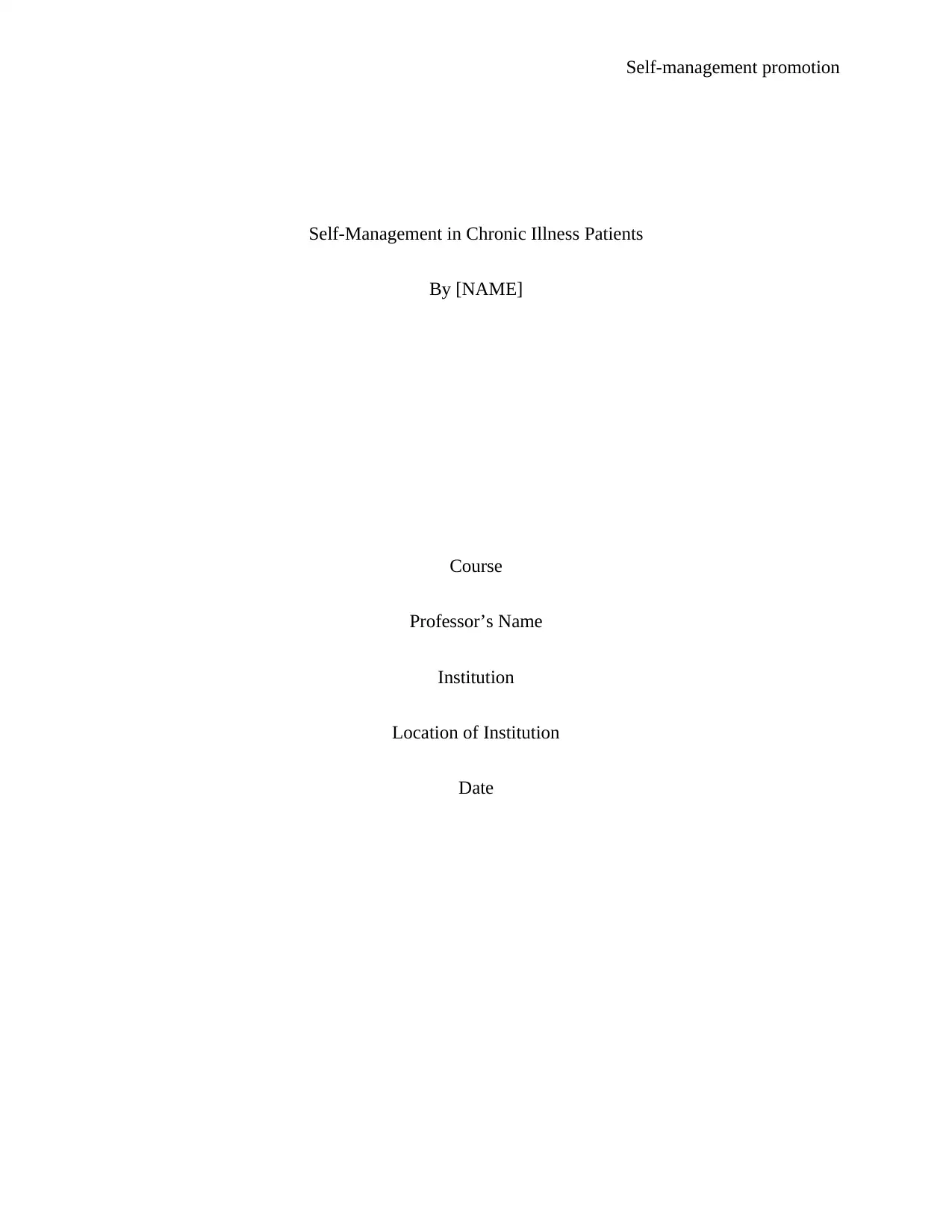
Self-management promotion
Self-Management in Chronic Illness Patients
By [NAME]
Course
Professor’s Name
Institution
Location of Institution
Date
Self-Management in Chronic Illness Patients
By [NAME]
Course
Professor’s Name
Institution
Location of Institution
Date
Paraphrase This Document
Need a fresh take? Get an instant paraphrase of this document with our AI Paraphraser
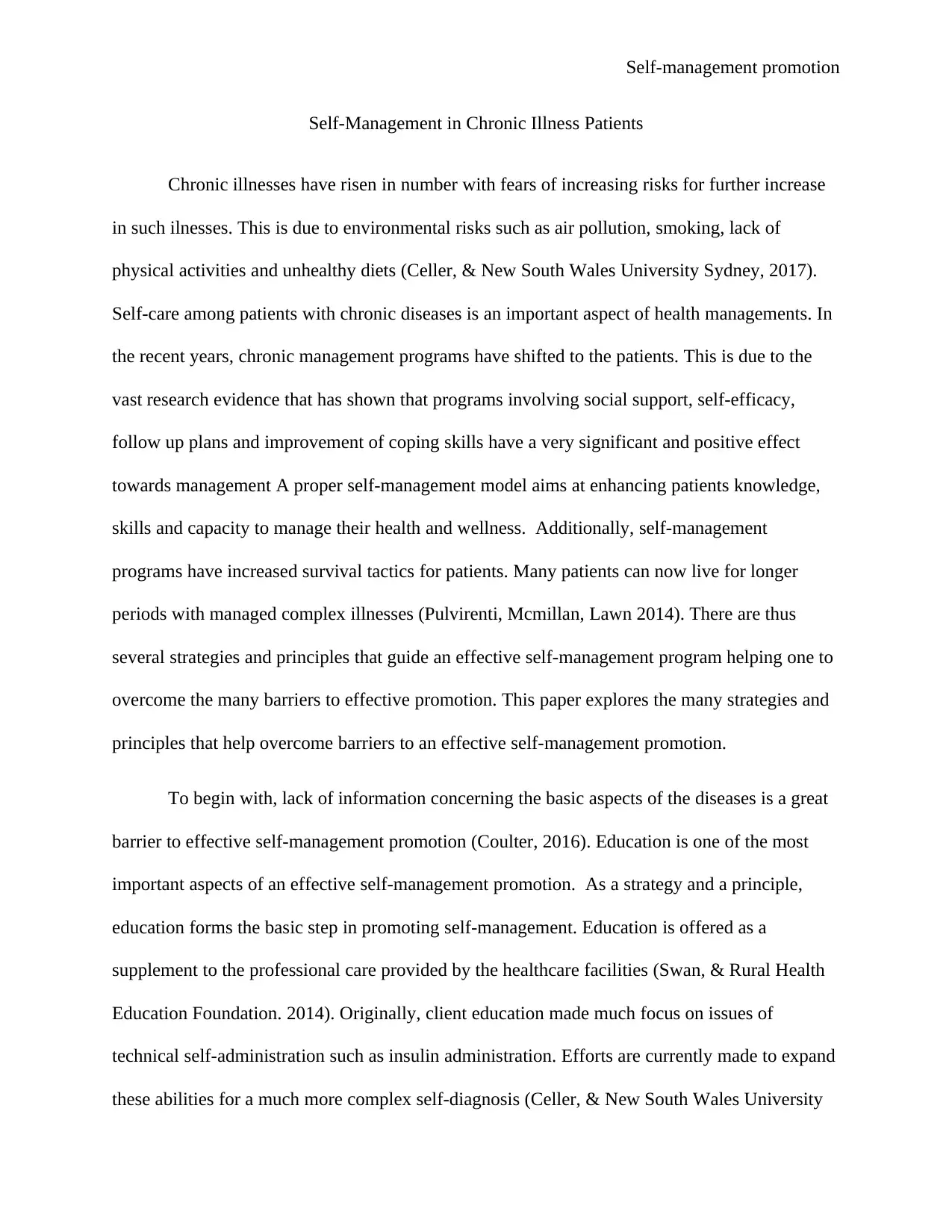
Self-management promotion
Self-Management in Chronic Illness Patients
Chronic illnesses have risen in number with fears of increasing risks for further increase
in such ilnesses. This is due to environmental risks such as air pollution, smoking, lack of
physical activities and unhealthy diets (Celler, & New South Wales University Sydney, 2017).
Self-care among patients with chronic diseases is an important aspect of health managements. In
the recent years, chronic management programs have shifted to the patients. This is due to the
vast research evidence that has shown that programs involving social support, self-efficacy,
follow up plans and improvement of coping skills have a very significant and positive effect
towards management A proper self-management model aims at enhancing patients knowledge,
skills and capacity to manage their health and wellness. Additionally, self-management
programs have increased survival tactics for patients. Many patients can now live for longer
periods with managed complex illnesses (Pulvirenti, Mcmillan, Lawn 2014). There are thus
several strategies and principles that guide an effective self-management program helping one to
overcome the many barriers to effective promotion. This paper explores the many strategies and
principles that help overcome barriers to an effective self-management promotion.
To begin with, lack of information concerning the basic aspects of the diseases is a great
barrier to effective self-management promotion (Coulter, 2016). Education is one of the most
important aspects of an effective self-management promotion. As a strategy and a principle,
education forms the basic step in promoting self-management. Education is offered as a
supplement to the professional care provided by the healthcare facilities (Swan, & Rural Health
Education Foundation. 2014). Originally, client education made much focus on issues of
technical self-administration such as insulin administration. Efforts are currently made to expand
these abilities for a much more complex self-diagnosis (Celler, & New South Wales University
Self-Management in Chronic Illness Patients
Chronic illnesses have risen in number with fears of increasing risks for further increase
in such ilnesses. This is due to environmental risks such as air pollution, smoking, lack of
physical activities and unhealthy diets (Celler, & New South Wales University Sydney, 2017).
Self-care among patients with chronic diseases is an important aspect of health managements. In
the recent years, chronic management programs have shifted to the patients. This is due to the
vast research evidence that has shown that programs involving social support, self-efficacy,
follow up plans and improvement of coping skills have a very significant and positive effect
towards management A proper self-management model aims at enhancing patients knowledge,
skills and capacity to manage their health and wellness. Additionally, self-management
programs have increased survival tactics for patients. Many patients can now live for longer
periods with managed complex illnesses (Pulvirenti, Mcmillan, Lawn 2014). There are thus
several strategies and principles that guide an effective self-management program helping one to
overcome the many barriers to effective promotion. This paper explores the many strategies and
principles that help overcome barriers to an effective self-management promotion.
To begin with, lack of information concerning the basic aspects of the diseases is a great
barrier to effective self-management promotion (Coulter, 2016). Education is one of the most
important aspects of an effective self-management promotion. As a strategy and a principle,
education forms the basic step in promoting self-management. Education is offered as a
supplement to the professional care provided by the healthcare facilities (Swan, & Rural Health
Education Foundation. 2014). Originally, client education made much focus on issues of
technical self-administration such as insulin administration. Efforts are currently made to expand
these abilities for a much more complex self-diagnosis (Celler, & New South Wales University
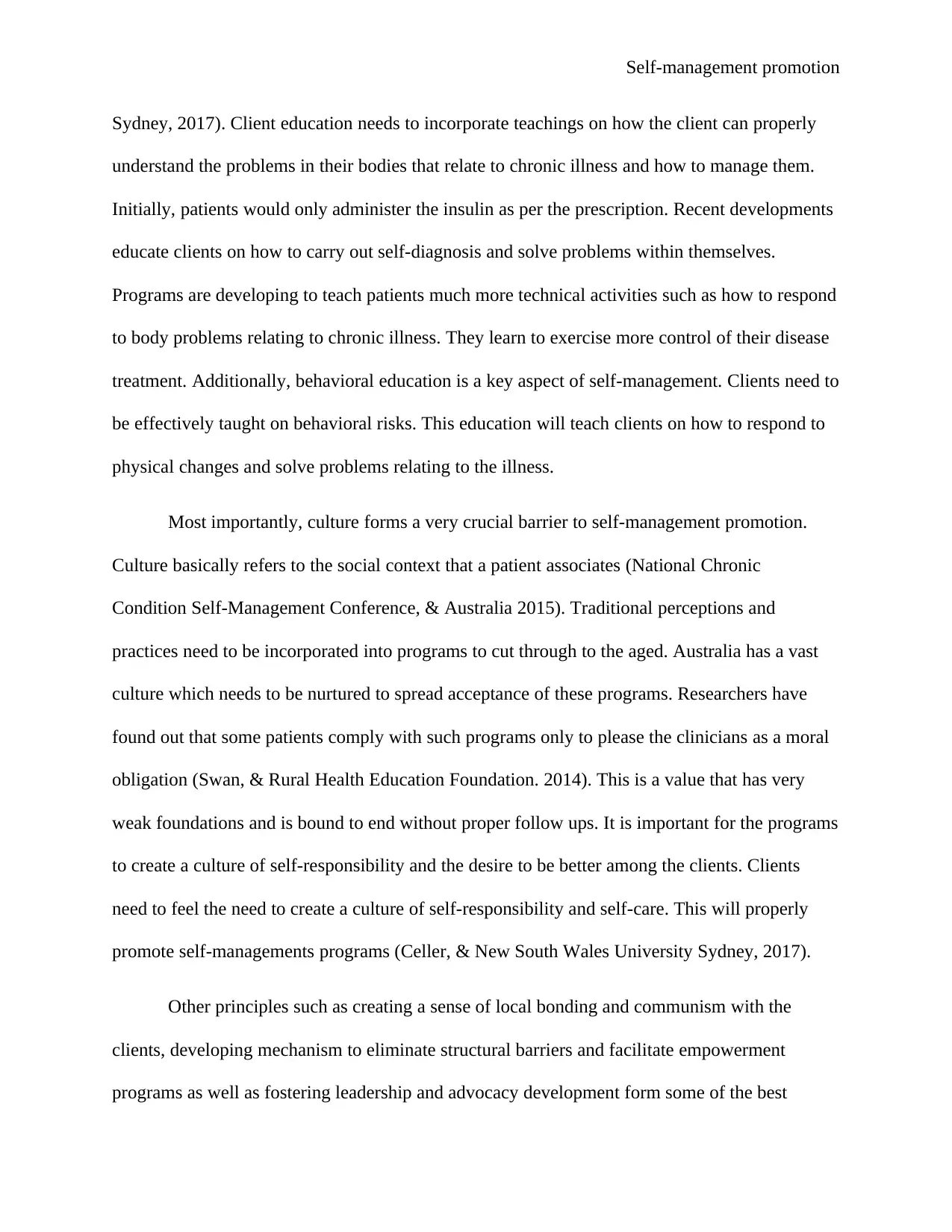
Self-management promotion
Sydney, 2017). Client education needs to incorporate teachings on how the client can properly
understand the problems in their bodies that relate to chronic illness and how to manage them.
Initially, patients would only administer the insulin as per the prescription. Recent developments
educate clients on how to carry out self-diagnosis and solve problems within themselves.
Programs are developing to teach patients much more technical activities such as how to respond
to body problems relating to chronic illness. They learn to exercise more control of their disease
treatment. Additionally, behavioral education is a key aspect of self-management. Clients need to
be effectively taught on behavioral risks. This education will teach clients on how to respond to
physical changes and solve problems relating to the illness.
Most importantly, culture forms a very crucial barrier to self-management promotion.
Culture basically refers to the social context that a patient associates (National Chronic
Condition Self-Management Conference, & Australia 2015). Traditional perceptions and
practices need to be incorporated into programs to cut through to the aged. Australia has a vast
culture which needs to be nurtured to spread acceptance of these programs. Researchers have
found out that some patients comply with such programs only to please the clinicians as a moral
obligation (Swan, & Rural Health Education Foundation. 2014). This is a value that has very
weak foundations and is bound to end without proper follow ups. It is important for the programs
to create a culture of self-responsibility and the desire to be better among the clients. Clients
need to feel the need to create a culture of self-responsibility and self-care. This will properly
promote self-managements programs (Celler, & New South Wales University Sydney, 2017).
Other principles such as creating a sense of local bonding and communism with the
clients, developing mechanism to eliminate structural barriers and facilitate empowerment
programs as well as fostering leadership and advocacy development form some of the best
Sydney, 2017). Client education needs to incorporate teachings on how the client can properly
understand the problems in their bodies that relate to chronic illness and how to manage them.
Initially, patients would only administer the insulin as per the prescription. Recent developments
educate clients on how to carry out self-diagnosis and solve problems within themselves.
Programs are developing to teach patients much more technical activities such as how to respond
to body problems relating to chronic illness. They learn to exercise more control of their disease
treatment. Additionally, behavioral education is a key aspect of self-management. Clients need to
be effectively taught on behavioral risks. This education will teach clients on how to respond to
physical changes and solve problems relating to the illness.
Most importantly, culture forms a very crucial barrier to self-management promotion.
Culture basically refers to the social context that a patient associates (National Chronic
Condition Self-Management Conference, & Australia 2015). Traditional perceptions and
practices need to be incorporated into programs to cut through to the aged. Australia has a vast
culture which needs to be nurtured to spread acceptance of these programs. Researchers have
found out that some patients comply with such programs only to please the clinicians as a moral
obligation (Swan, & Rural Health Education Foundation. 2014). This is a value that has very
weak foundations and is bound to end without proper follow ups. It is important for the programs
to create a culture of self-responsibility and the desire to be better among the clients. Clients
need to feel the need to create a culture of self-responsibility and self-care. This will properly
promote self-managements programs (Celler, & New South Wales University Sydney, 2017).
Other principles such as creating a sense of local bonding and communism with the
clients, developing mechanism to eliminate structural barriers and facilitate empowerment
programs as well as fostering leadership and advocacy development form some of the best
⊘ This is a preview!⊘
Do you want full access?
Subscribe today to unlock all pages.

Trusted by 1+ million students worldwide
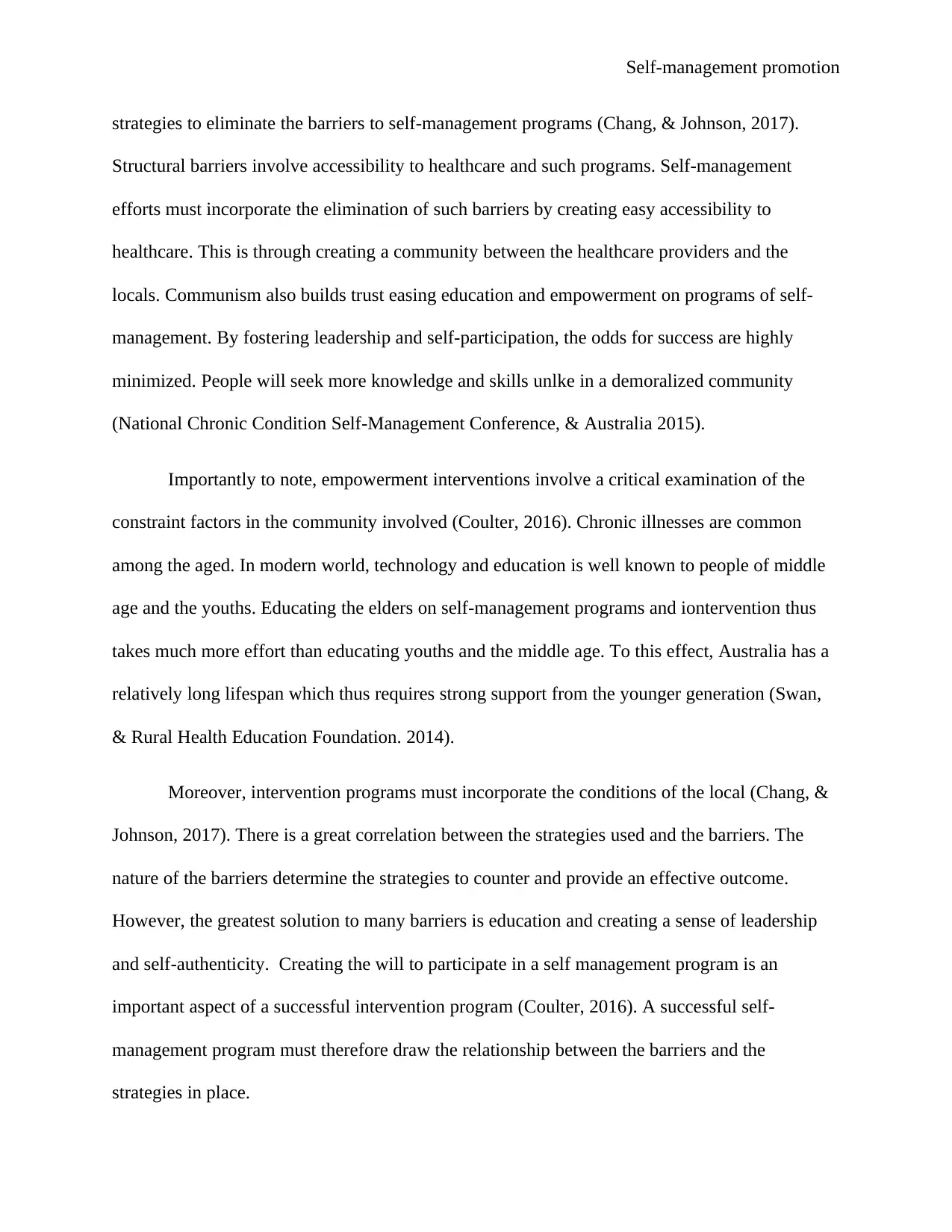
Self-management promotion
strategies to eliminate the barriers to self-management programs (Chang, & Johnson, 2017).
Structural barriers involve accessibility to healthcare and such programs. Self-management
efforts must incorporate the elimination of such barriers by creating easy accessibility to
healthcare. This is through creating a community between the healthcare providers and the
locals. Communism also builds trust easing education and empowerment on programs of self-
management. By fostering leadership and self-participation, the odds for success are highly
minimized. People will seek more knowledge and skills unlke in a demoralized community
(National Chronic Condition Self-Management Conference, & Australia 2015).
Importantly to note, empowerment interventions involve a critical examination of the
constraint factors in the community involved (Coulter, 2016). Chronic illnesses are common
among the aged. In modern world, technology and education is well known to people of middle
age and the youths. Educating the elders on self-management programs and iontervention thus
takes much more effort than educating youths and the middle age. To this effect, Australia has a
relatively long lifespan which thus requires strong support from the younger generation (Swan,
& Rural Health Education Foundation. 2014).
Moreover, intervention programs must incorporate the conditions of the local (Chang, &
Johnson, 2017). There is a great correlation between the strategies used and the barriers. The
nature of the barriers determine the strategies to counter and provide an effective outcome.
However, the greatest solution to many barriers is education and creating a sense of leadership
and self-authenticity. Creating the will to participate in a self management program is an
important aspect of a successful intervention program (Coulter, 2016). A successful self-
management program must therefore draw the relationship between the barriers and the
strategies in place.
strategies to eliminate the barriers to self-management programs (Chang, & Johnson, 2017).
Structural barriers involve accessibility to healthcare and such programs. Self-management
efforts must incorporate the elimination of such barriers by creating easy accessibility to
healthcare. This is through creating a community between the healthcare providers and the
locals. Communism also builds trust easing education and empowerment on programs of self-
management. By fostering leadership and self-participation, the odds for success are highly
minimized. People will seek more knowledge and skills unlke in a demoralized community
(National Chronic Condition Self-Management Conference, & Australia 2015).
Importantly to note, empowerment interventions involve a critical examination of the
constraint factors in the community involved (Coulter, 2016). Chronic illnesses are common
among the aged. In modern world, technology and education is well known to people of middle
age and the youths. Educating the elders on self-management programs and iontervention thus
takes much more effort than educating youths and the middle age. To this effect, Australia has a
relatively long lifespan which thus requires strong support from the younger generation (Swan,
& Rural Health Education Foundation. 2014).
Moreover, intervention programs must incorporate the conditions of the local (Chang, &
Johnson, 2017). There is a great correlation between the strategies used and the barriers. The
nature of the barriers determine the strategies to counter and provide an effective outcome.
However, the greatest solution to many barriers is education and creating a sense of leadership
and self-authenticity. Creating the will to participate in a self management program is an
important aspect of a successful intervention program (Coulter, 2016). A successful self-
management program must therefore draw the relationship between the barriers and the
strategies in place.
Paraphrase This Document
Need a fresh take? Get an instant paraphrase of this document with our AI Paraphraser
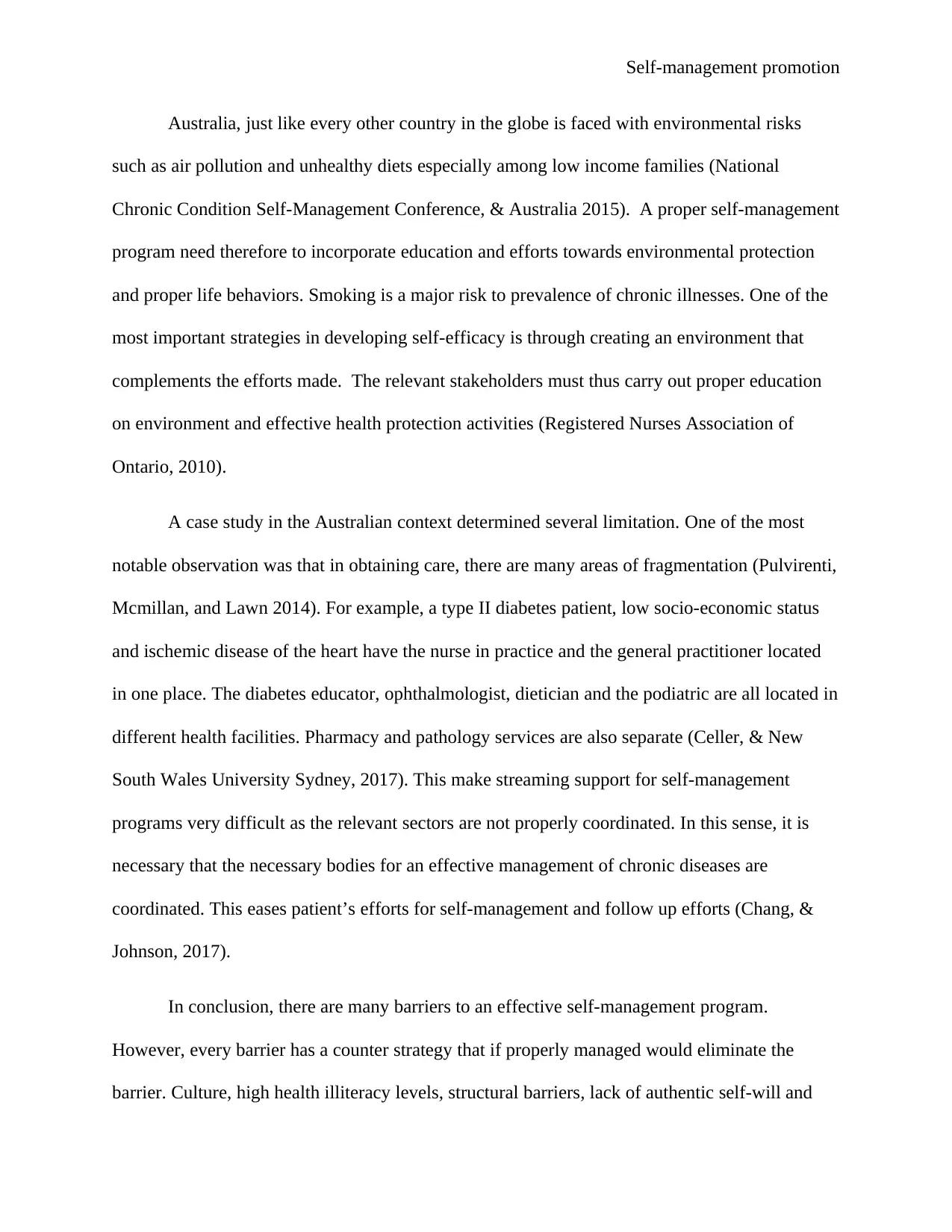
Self-management promotion
Australia, just like every other country in the globe is faced with environmental risks
such as air pollution and unhealthy diets especially among low income families (National
Chronic Condition Self-Management Conference, & Australia 2015). A proper self-management
program need therefore to incorporate education and efforts towards environmental protection
and proper life behaviors. Smoking is a major risk to prevalence of chronic illnesses. One of the
most important strategies in developing self-efficacy is through creating an environment that
complements the efforts made. The relevant stakeholders must thus carry out proper education
on environment and effective health protection activities (Registered Nurses Association of
Ontario, 2010).
A case study in the Australian context determined several limitation. One of the most
notable observation was that in obtaining care, there are many areas of fragmentation (Pulvirenti,
Mcmillan, and Lawn 2014). For example, a type II diabetes patient, low socio-economic status
and ischemic disease of the heart have the nurse in practice and the general practitioner located
in one place. The diabetes educator, ophthalmologist, dietician and the podiatric are all located in
different health facilities. Pharmacy and pathology services are also separate (Celler, & New
South Wales University Sydney, 2017). This make streaming support for self-management
programs very difficult as the relevant sectors are not properly coordinated. In this sense, it is
necessary that the necessary bodies for an effective management of chronic diseases are
coordinated. This eases patient’s efforts for self-management and follow up efforts (Chang, &
Johnson, 2017).
In conclusion, there are many barriers to an effective self-management program.
However, every barrier has a counter strategy that if properly managed would eliminate the
barrier. Culture, high health illiteracy levels, structural barriers, lack of authentic self-will and
Australia, just like every other country in the globe is faced with environmental risks
such as air pollution and unhealthy diets especially among low income families (National
Chronic Condition Self-Management Conference, & Australia 2015). A proper self-management
program need therefore to incorporate education and efforts towards environmental protection
and proper life behaviors. Smoking is a major risk to prevalence of chronic illnesses. One of the
most important strategies in developing self-efficacy is through creating an environment that
complements the efforts made. The relevant stakeholders must thus carry out proper education
on environment and effective health protection activities (Registered Nurses Association of
Ontario, 2010).
A case study in the Australian context determined several limitation. One of the most
notable observation was that in obtaining care, there are many areas of fragmentation (Pulvirenti,
Mcmillan, and Lawn 2014). For example, a type II diabetes patient, low socio-economic status
and ischemic disease of the heart have the nurse in practice and the general practitioner located
in one place. The diabetes educator, ophthalmologist, dietician and the podiatric are all located in
different health facilities. Pharmacy and pathology services are also separate (Celler, & New
South Wales University Sydney, 2017). This make streaming support for self-management
programs very difficult as the relevant sectors are not properly coordinated. In this sense, it is
necessary that the necessary bodies for an effective management of chronic diseases are
coordinated. This eases patient’s efforts for self-management and follow up efforts (Chang, &
Johnson, 2017).
In conclusion, there are many barriers to an effective self-management program.
However, every barrier has a counter strategy that if properly managed would eliminate the
barrier. Culture, high health illiteracy levels, structural barriers, lack of authentic self-will and
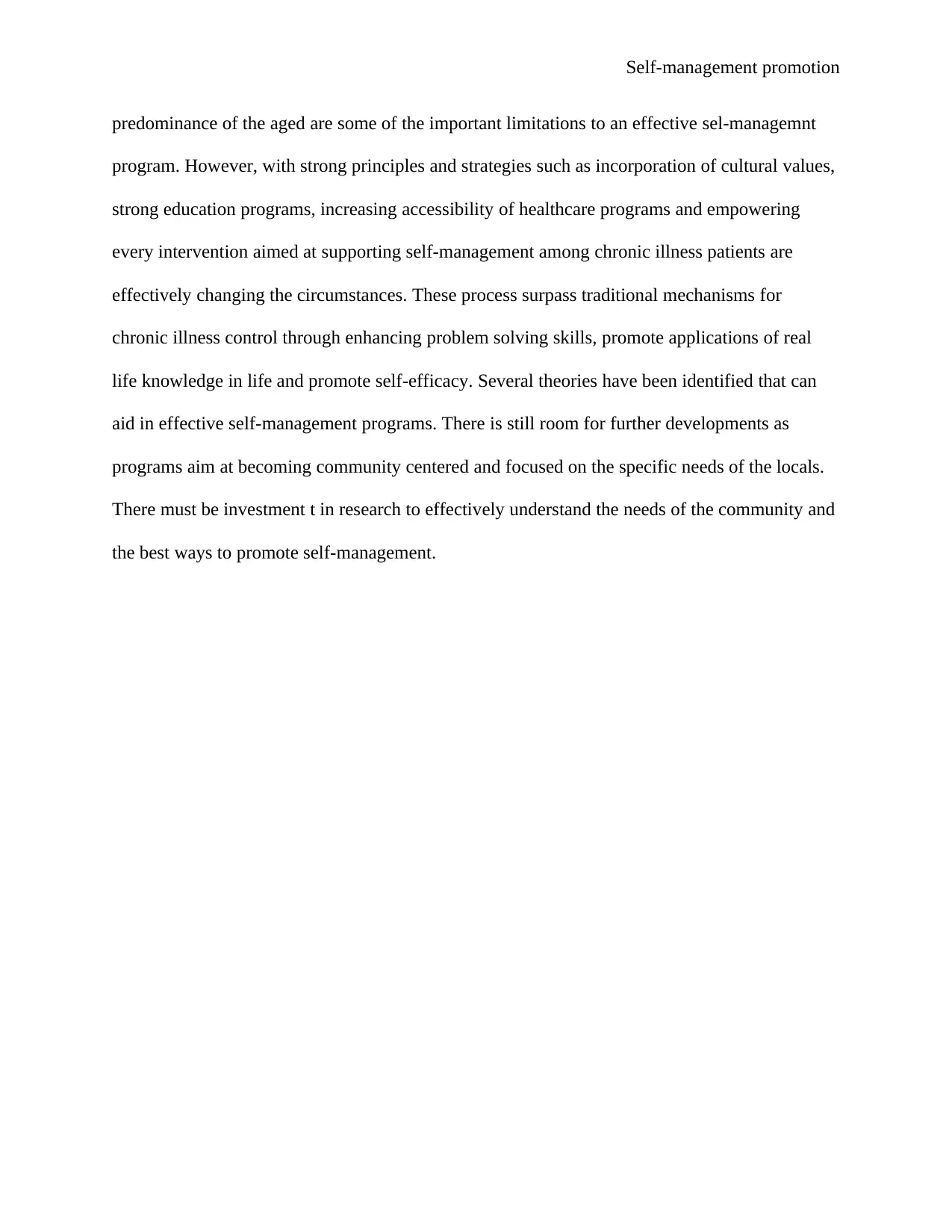
Self-management promotion
predominance of the aged are some of the important limitations to an effective sel-managemnt
program. However, with strong principles and strategies such as incorporation of cultural values,
strong education programs, increasing accessibility of healthcare programs and empowering
every intervention aimed at supporting self-management among chronic illness patients are
effectively changing the circumstances. These process surpass traditional mechanisms for
chronic illness control through enhancing problem solving skills, promote applications of real
life knowledge in life and promote self-efficacy. Several theories have been identified that can
aid in effective self-management programs. There is still room for further developments as
programs aim at becoming community centered and focused on the specific needs of the locals.
There must be investment t in research to effectively understand the needs of the community and
the best ways to promote self-management.
predominance of the aged are some of the important limitations to an effective sel-managemnt
program. However, with strong principles and strategies such as incorporation of cultural values,
strong education programs, increasing accessibility of healthcare programs and empowering
every intervention aimed at supporting self-management among chronic illness patients are
effectively changing the circumstances. These process surpass traditional mechanisms for
chronic illness control through enhancing problem solving skills, promote applications of real
life knowledge in life and promote self-efficacy. Several theories have been identified that can
aid in effective self-management programs. There is still room for further developments as
programs aim at becoming community centered and focused on the specific needs of the locals.
There must be investment t in research to effectively understand the needs of the community and
the best ways to promote self-management.
⊘ This is a preview!⊘
Do you want full access?
Subscribe today to unlock all pages.

Trusted by 1+ million students worldwide
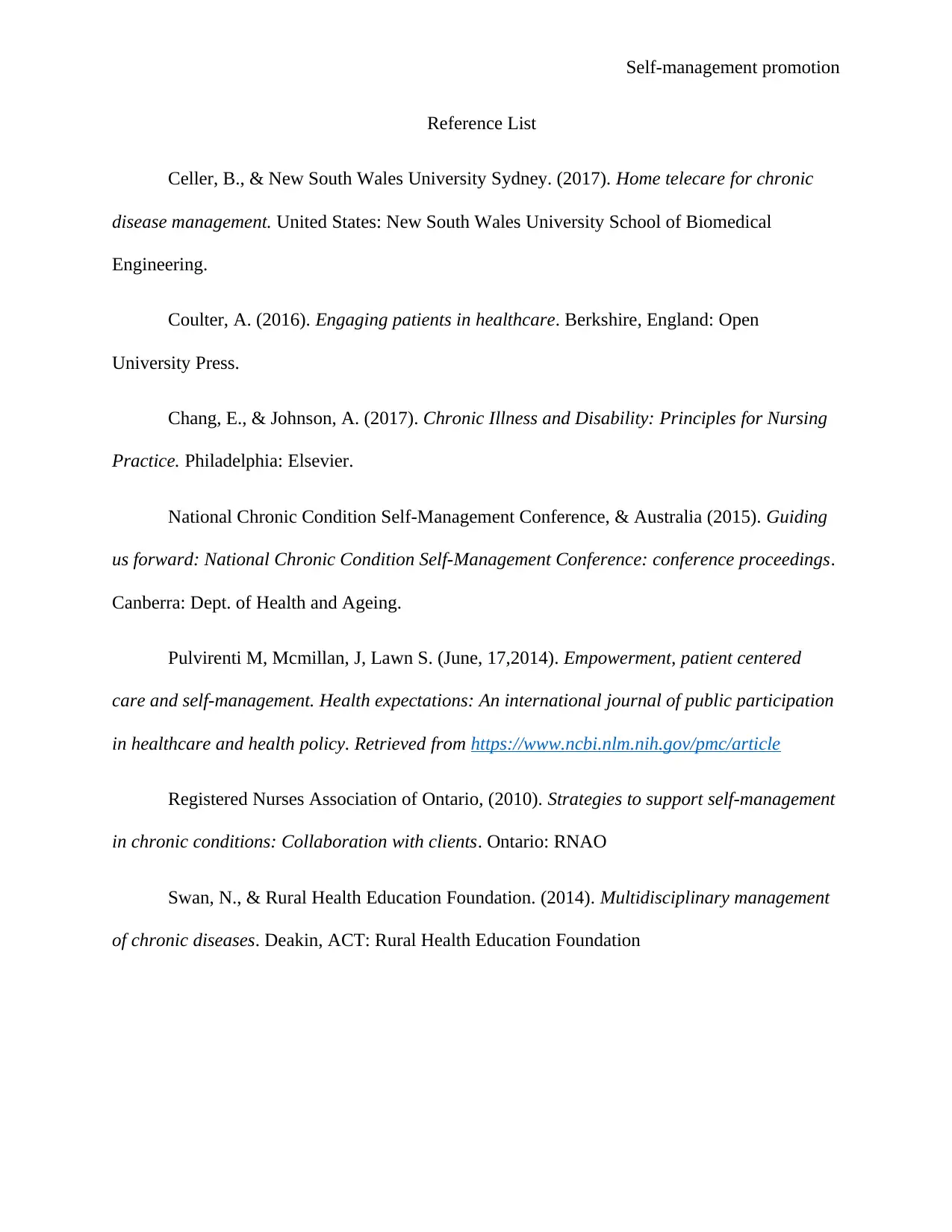
Self-management promotion
Reference List
Celler, B., & New South Wales University Sydney. (2017). Home telecare for chronic
disease management. United States: New South Wales University School of Biomedical
Engineering.
Coulter, A. (2016). Engaging patients in healthcare. Berkshire, England: Open
University Press.
Chang, E., & Johnson, A. (2017). Chronic Illness and Disability: Principles for Nursing
Practice. Philadelphia: Elsevier.
National Chronic Condition Self-Management Conference, & Australia (2015). Guiding
us forward: National Chronic Condition Self-Management Conference: conference proceedings.
Canberra: Dept. of Health and Ageing.
Pulvirenti M, Mcmillan, J, Lawn S. (June, 17,2014). Empowerment, patient centered
care and self-management. Health expectations: An international journal of public participation
in healthcare and health policy. Retrieved from https://www.ncbi.nlm.nih.gov/pmc/article
Registered Nurses Association of Ontario, (2010). Strategies to support self-management
in chronic conditions: Collaboration with clients. Ontario: RNAO
Swan, N., & Rural Health Education Foundation. (2014). Multidisciplinary management
of chronic diseases. Deakin, ACT: Rural Health Education Foundation
Reference List
Celler, B., & New South Wales University Sydney. (2017). Home telecare for chronic
disease management. United States: New South Wales University School of Biomedical
Engineering.
Coulter, A. (2016). Engaging patients in healthcare. Berkshire, England: Open
University Press.
Chang, E., & Johnson, A. (2017). Chronic Illness and Disability: Principles for Nursing
Practice. Philadelphia: Elsevier.
National Chronic Condition Self-Management Conference, & Australia (2015). Guiding
us forward: National Chronic Condition Self-Management Conference: conference proceedings.
Canberra: Dept. of Health and Ageing.
Pulvirenti M, Mcmillan, J, Lawn S. (June, 17,2014). Empowerment, patient centered
care and self-management. Health expectations: An international journal of public participation
in healthcare and health policy. Retrieved from https://www.ncbi.nlm.nih.gov/pmc/article
Registered Nurses Association of Ontario, (2010). Strategies to support self-management
in chronic conditions: Collaboration with clients. Ontario: RNAO
Swan, N., & Rural Health Education Foundation. (2014). Multidisciplinary management
of chronic diseases. Deakin, ACT: Rural Health Education Foundation
1 out of 7
Related Documents
Your All-in-One AI-Powered Toolkit for Academic Success.
+13062052269
info@desklib.com
Available 24*7 on WhatsApp / Email
![[object Object]](/_next/static/media/star-bottom.7253800d.svg)
Unlock your academic potential
Copyright © 2020–2025 A2Z Services. All Rights Reserved. Developed and managed by ZUCOL.





